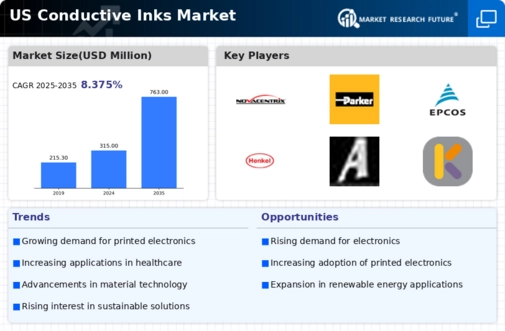The conductive inks market is characterized by a dynamic competitive landscape, driven by innovation and technological advancements. Key players such as DuPont (US), Henkel (DE), and Nano Dimension (IL) are actively shaping the market through strategic initiatives. DuPont (US) focuses on enhancing its product portfolio with advanced materials, while Henkel (DE) emphasizes sustainability in its manufacturing processes. Meanwhile, Nano Dimension (IL) is leveraging its expertise in 3D printing technologies to create innovative conductive inks, indicating a trend towards integrating advanced manufacturing techniques into traditional ink production. Collectively, these strategies contribute to a competitive environment that prioritizes innovation and sustainability.
In terms of business tactics, companies are increasingly localizing manufacturing to reduce lead times and optimize supply chains. The market appears moderately fragmented, with several players vying for market share. However, the influence of major companies like DuPont (US) and Henkel (DE) is substantial, as they set industry standards and drive technological advancements. This competitive structure suggests that while there is room for smaller players, the dominance of established firms shapes market dynamics significantly.
In October 2025, DuPont (US) announced a partnership with a leading electronics manufacturer to develop next-generation conductive inks tailored for flexible electronics. This collaboration is strategically important as it positions DuPont (US) at the forefront of the growing flexible electronics market, which is expected to expand rapidly in the coming years. By aligning with a key player in the electronics sector, DuPont (US) enhances its market reach and reinforces its commitment to innovation.
In September 2025, Henkel (DE) launched a new line of eco-friendly conductive inks designed for use in various applications, including automotive and consumer electronics. This move underscores Henkel's (DE) strategic focus on sustainability, responding to increasing consumer demand for environmentally friendly products. The introduction of these inks not only strengthens Henkel's (DE) product offerings but also positions the company as a leader in sustainable practices within the conductive inks market.
In August 2025, Nano Dimension (IL) expanded its production capabilities by investing in a new facility dedicated to the manufacturing of conductive inks. This investment is indicative of Nano Dimension's (IL) commitment to scaling its operations and meeting the rising demand for advanced materials in the 3D printing sector. By enhancing its production capacity, the company is likely to improve its competitive edge and respond more effectively to market needs.
As of November 2025, current trends in the conductive inks market include a strong emphasis on digitalization, sustainability, and the integration of AI technologies. Strategic alliances are increasingly shaping the competitive landscape, allowing companies to pool resources and expertise. Looking ahead, it appears that competitive differentiation will evolve from traditional price-based competition to a focus on innovation, technological advancements, and supply chain reliability. This shift suggests that companies that prioritize R&D and sustainable practices will likely emerge as leaders in the market.



















Leave a Comment